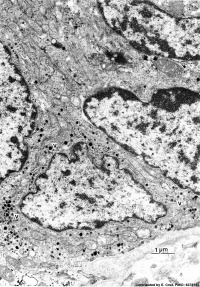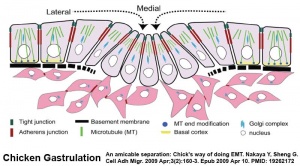Developmental Mechanism - Epithelial Mesenchymal Transition
| Embryology - 24 Apr 2024 |
|---|
| Google Translate - select your language from the list shown below (this will open a new external page) |
|
العربية | català | 中文 | 中國傳統的 | français | Deutsche | עִברִית | हिंदी | bahasa Indonesia | italiano | 日本語 | 한국어 | မြန်မာ | Pilipino | Polskie | português | ਪੰਜਾਬੀ ਦੇ | Română | русский | Español | Swahili | Svensk | ไทย | Türkçe | اردو | ייִדיש | Tiếng Việt These external translations are automated and may not be accurate. (More? About Translations) |
Introduction
Epithelial cells (organised cellular layer) which loose their organisation and migrate/proliferate as a mesenchymal cells (disorganised cellular layers) are said to have undergone an Epithelial Mesenchymal Transition (EMT).
Mesenchymal cells, connective tissue-like, that have undergone this process may at a later time and under specific signaling can undergo the opposite process, mesenchyme to epithelia. In development, this process can be repeated several times during tissue differentiation.
This process is also studied in carcinogenesis (oncogenesis) or cancer development, where part of this process can be the transformation of an epithelial cell into a mesenchymal cell.[1][2]
Some Recent Findings
|
| More recent papers |
|---|
|
This table allows an automated computer search of the external PubMed database using the listed "Search term" text link.
More? References | Discussion Page | Journal Searches | 2019 References | 2020 References Search term: Epithelial Mesenchymal Transition <pubmed limit=5>Epithelial Mesenchymal Transition</pubmed> |
Gastrulation
- Links:Gastrulation
Neural Crest Development
- Links:
Heart Development
During heart development endocardial and epicardial cells produce non-cardiomyocyte lineages undergo rounds of epithelial to mesenchymal transition, see review.[4]
Respiratory Development
| Neonatal Human | Fetal Rabbit |
|---|---|

|

|
| Pulmonary neuroendocrine cell (EM)[5] | Neuroepithelial body[5] |
Pulmonary Neuroendocrine Cells (PNECs) differentiate in the airway epithelium in late embryonic to early fetal period.[6][7] Later in the mid-fetal period clusters of these cells form neuroepithelial bodies (NEBs). The cells migrate to to form these clusters by a process involving transient epithelial to mesenchymal transition. The process of migration has recently been described as “slithering”[8], where the cells transiently lose epithelial characteristics but remain associated with the membrane while traversing neighboring epithelial cells to reach cluster sites.
Mesenchymal-to-Epithelial Transition
The alternate process involves the conversion of the embryonic connective tissue organization (mesenchyme) to an epithelial organization (epithelium) that can occur during developmental processes.
This process can be seen occurring during early somitogenesis.
It is also suggested that this mechanism occurs in the maternal uterus during endometrial regeneration following decidualization.[9][10]
References
Textbooks
Reviews
<pubmed></pubmed>
Articles
Search PubMed
Search Pubmed: Epithelial Mesenchymal Transition
External Links
External Links Notice - The dynamic nature of the internet may mean that some of these listed links may no longer function. If the link no longer works search the web with the link text or name. Links to any external commercial sites are provided for information purposes only and should never be considered an endorsement. UNSW Embryology is provided as an educational resource with no clinical information or commercial affiliation.
Glossary Links
- Glossary: A | B | C | D | E | F | G | H | I | J | K | L | M | N | O | P | Q | R | S | T | U | V | W | X | Y | Z | Numbers | Symbols | Term Link
Cite this page: Hill, M.A. (2024, April 24) Embryology Developmental Mechanism - Epithelial Mesenchymal Transition. Retrieved from https://embryology.med.unsw.edu.au/embryology/index.php/Developmental_Mechanism_-_Epithelial_Mesenchymal_Transition
- © Dr Mark Hill 2024, UNSW Embryology ISBN: 978 0 7334 2609 4 - UNSW CRICOS Provider Code No. 00098G

